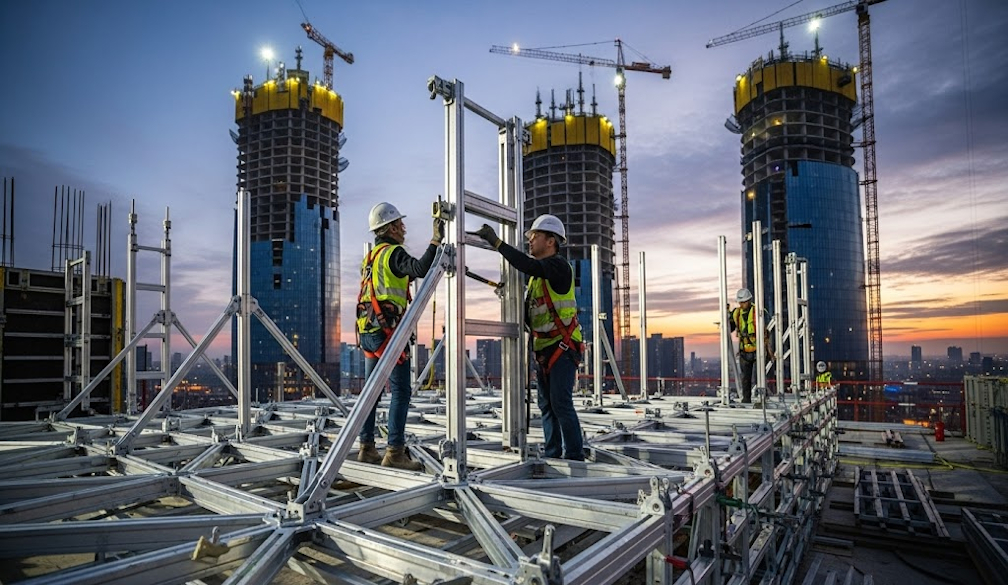Aluminium Scaffolding: Lightweight Efficiency for Safe Height Access

In the world of construction, maintenance, and industrial projects, the need to work safely and efficiently at height is critical. One solution that has gained immense popularity for its versatility and ease of use is aluminium scaffolding. Offering a perfect blend of lightweight design and robust performance, aluminium scaffolding is a go-to choice for tradespeople, contractors, and businesses across industries.
Whether it’s interior painting, electrical installations, façade repairs, or even event setups, aluminium scaffolding provides safe access without the heavy lifting or logistical hassles of traditional steel scaffolds. It’s practical, easy to transport, and built to meet the high safety standards expected on modern worksites.
Why Aluminium Scaffolding is a Game-Changer
The main advantage of aluminium scaffolding lies in its weight. Aluminium is significantly lighter than steel but still strong enough to handle demanding tasks. This means fewer workers are required to transport, erect, and dismantle the system. The result is a quicker, more streamlined process that reduces project timelines and labour costs.
Beyond ease of use, aluminium scaffolding is resistant to rust and corrosion, making it ideal for both indoor and outdoor use. Unlike timber platforms or heavy steel frames, aluminium components maintain their structural integrity in humid, coastal, or wet environments.
This durability ensures that the scaffolding system not only lasts longer but also maintains a clean, professional appearance on site—important for jobs in high-visibility commercial or residential areas.
Common Uses of Aluminium Scaffolding Across Industries
Aluminium scaffolding is used in a wide variety of environments. In construction, it allows for safe and mobile access to ceilings, walls, and roofing structures. In facilities maintenance, it’s ideal for tasks like replacing light fixtures, air conditioning installations, and ceiling repairs.
For painters, decorators, and window cleaners, aluminium scaffolding offers portability and ease of setup that ladders can’t match. It also supports longer working durations at height without the instability that comes with tall ladder use.
Event companies rely on aluminium scaffolding for constructing temporary structures, banners, lighting rigs, and stage platforms. Its modular design makes it easy to configure into various shapes and heights based on project requirements.
Types of Aluminium Scaffolding Available
Depending on the task and location, different types of aluminium scaffolding are available. Mobile aluminium towers are one of the most commonly used versions. These are built on lockable castor wheels, allowing the entire scaffold to be rolled into position and secured when needed.
Foldable models are useful for indoor tasks, such as installing wiring or ductwork in narrow corridors or tight spaces. These can be collapsed for easy transport in small vans or utes. For more demanding outdoor work, double-width scaffolding towers provide greater platform space, accommodating more tools and multiple users simultaneously.
Advanced systems include integrated ladders, guardrails, and non-slip platforms—features that enhance user safety while meeting compliance standards. Some scaffold suppliers also offer customisable modular kits tailored to specific industry requirements.
Safety Benefits of Aluminium Scaffolding
Despite being lighter than steel, aluminium scaffolding doesn’t compromise on safety. In fact, many systems are engineered to meet or exceed Australian safety regulations. Key safety features include high-load capacity platforms, bracing systems to prevent sway, guardrails to prevent falls, and lockable wheels or base plates to maintain stability.
Because aluminium doesn’t rust, structural weaknesses due to corrosion are less of a concern. This means less maintenance and a reduced chance of component failure during use.
Proper setup and daily inspection are still vital. Regular checks for damage, secure locking of joints, and careful positioning on stable ground ensure the aluminium scaffolding system performs safely throughout its use.
Easy Transport and Storage
One of the most practical advantages of aluminium scaffolding is its transportability. Its light weight means it can be moved without cranes or forklifts, and individual components are often manageable by a single person. This ease of movement is especially useful for tradespeople who need to work across multiple sites in a single day.
Storage is equally straightforward. Many systems can be disassembled and flat-packed, requiring minimal space. Foldable towers, in particular, are popular among solo operators and small contractors due to their space-saving design and ease of handling.
Cost Benefits for Businesses and Contractors
Though initial purchase prices for aluminium scaffolding may be slightly higher than steel, the long-term cost savings make it a smart investment. Its lower transport and labour costs, reduced risk of rust damage, and minimal maintenance requirements all contribute to a lower total cost of ownership.
Additionally, the modular nature of aluminium scaffolding means components can be reused and reconfigured across different jobs. For businesses with recurring projects or varied access needs, this flexibility translates to financial efficiency and operational adaptability.
Hiring vs. Purchasing Aluminium Scaffolding
Depending on your needs, you can either hire or purchase aluminium scaffolding. For short-term or infrequent tasks, hiring offers a more cost-effective solution. Many suppliers in Melbourne and other cities offer flexible rental plans that include delivery, installation, and removal.
For contractors or organisations with ongoing requirements, purchasing your own aluminium scaffolding makes sense. It provides round-the-clock access, removes scheduling constraints with hire companies, and offers long-term savings.
Some scaffolding suppliers also offer training for safe use, as well as maintenance packages to ensure your system remains compliant with safety standards.
Conclusion: Aluminium Scaffolding is the Modern Tradesperson’s Best Friend
In construction, maintenance, events, and interior work, aluminium scaffolding stands out as a tool that offers mobility, strength, and safety. Its lightweight nature, combined with rust resistance and modular design, make it ideal for a wide variety of tasks.
Whether you're scaling interior walls or performing detailed exterior restoration, aluminium scaffolding offers the confidence of secure footing and the convenience of easy assembly. It's a smart investment that enhances productivity while keeping workers safe—making it the trusted choice for projects big and small.




